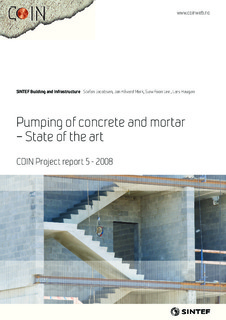| dc.description.abstract | The pumpability of concrete, or its ability to move through pipes and hoses by the help of a pump while maintaining its fresh and hardened properties, can be quantified as being better the lower the necessary pressure to obtain a given flow in a specific configuration and set-up (pump type, -capacity, pipes/hoses, –diameter/length etc). The practical pumping process including the principles of piston- and screw pumps show that for a wide range of concretes the flow in a given set-up is approximately proportional to pump-frequency whereas resulting pressure depends on concrete technological parameters (concrete composition, rheology). Based on review and some preliminary pumping trials in the NTNU concrete laboratory we propose concrete pressure gradient over the pipe length as a measure of pumpability for a given pump set-up.
We then present some results on flow measurements in experiments on commercial premix products and open lab concretes and mortars. Measurements of rheological parameters in the BML-viscometer, concrete pressure in pipe , concrete flow and energy in an instrumented full-scale pump-set up with a screw pump indicate that plastic viscosity is the main rheological parameter affecting pumpability. Analysis of the degree of plug flow indicates a wide variety of flow profiles. A simplified 2D FEM analysis with Navier Stokes equation using Papanastasious solution for Bingham fluid gives convergent flow with similar plug flow profiles as the analytical Buckingham Reiner equation. An analytical slip layer model was developed applying the Bingham model. It can be fitted to plug flow but more experiments are needed on what the boundary flow looks like.
Continued research should study plug flow, slip layers and concrete rheology effects (admixtures, matrix volume and –properties) on pumpability including effects of pump frequency, increasing vs decreasing flow, hose characteristics (material, diameter, length, height etc). This could also be used in form filling experiments. A reliable numerical model must describe both flow through the pump and pipes/hoses as well as the form filling satisfactorily. | nb_NO |
